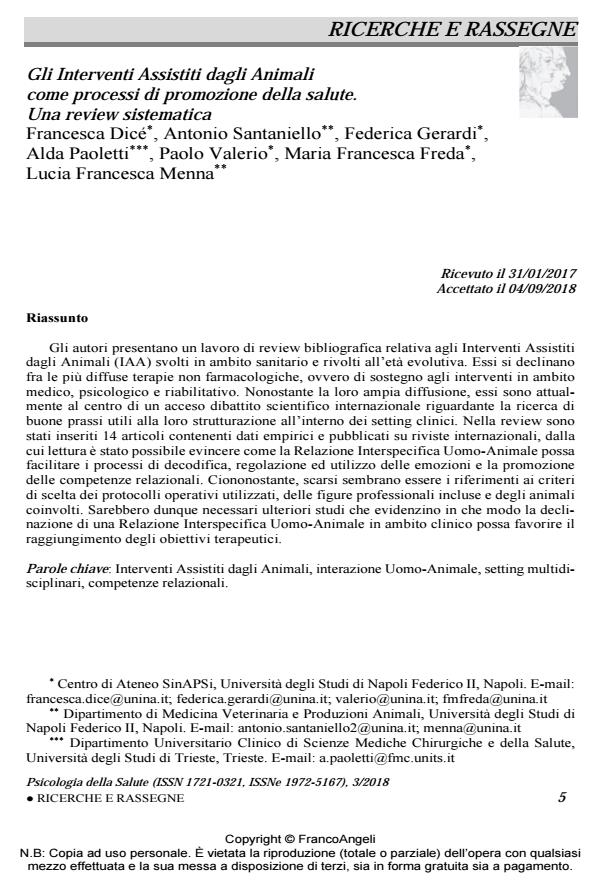Animal-Assisted Interventions as health promotion processes. A systematic review
Journal title PSICOLOGIA DELLA SALUTE
Author/s Francesca Dicé, Antonio Santaniello, Federica Gerardi, Alda Paoletti, Paolo Valerio, Maria Francesca Freda, Lucia Francesca Menna
Publishing Year 2018 Issue 2018/3
Language Italian Pages 19 P. 5-23 File size 223 KB
DOI 10.3280/PDS2018-003001
DOI is like a bar code for intellectual property: to have more infomation
click here
Below, you can see the article first page
If you want to buy this article in PDF format, you can do it, following the instructions to buy download credits

FrancoAngeli is member of Publishers International Linking Association, Inc (PILA), a not-for-profit association which run the CrossRef service enabling links to and from online scholarly content.
Authors present a literature review about Animal-Assisted Interventions (AAI) in health care context and aimed to children. They are considered as valid auxiliary therapies, useful to support initiatives in medical, psychological and rehabilitation field. Despite their widespread use, they are discussed in an international scientific debate about best practices for structuring this clinical setting. In this review, 14 original articles, containing empirical data and published in international journals were included. In them, HAI is described as a promoter for processes of decoding, control and use of the emotions, and for promotion of relational skills. Nevertheless, there are few indications about criteria for the choices about operating protocols, professionals included and involved pets. Further studies, highlighting how the declination of HAI in clinical settings can facilitate the achievement of therapeutic goals, are required.
Keywords: Animal-Assisted Interventions, Human Animal Interaction, Multidisciplinary Settings, Relational Skills
- The Semiotic Paradigm in Psychology. A Mature Weltanschauung for the Definition of Semiotic Mind Raffaele De Luca Picione, in Integrative Psychological and Behavioral Science /2020 pp.639
DOI: 10.1007/s12124-020-09555-y - Exploring emotions in dialog between health provider, parent and child. An observational study in pediatric primary care Francesca Dicé, Pasquale Dolce, Assunta Maiello, Maria Francesca Freda, in Pratiques Psychologiques /2020 pp.69
DOI: 10.1016/j.prps.2018.12.001 - Foundation of Ethics-Based Practices Raffaele De Luca Picione, Maria Francesca Freda, Livia Savarese, pp.115 (ISBN:978-3-030-83665-8)
- A Systematic Review of Metacognitive Beliefs in Chronic Medical Conditions Vittorio Lenzo, Alberto Sardella, Gabriella Martino, Maria C. Quattropani, in Frontiers in Psychology 2875/2020
DOI: 10.3389/fpsyg.2019.02875 - The Semiotic Construction of the Sense of Agency. The Modal Articulation in Narrative Processes Raffaele De Luca Picione, Maria Luisa Martino, Gina Troisi, in Integrative Psychological and Behavioral Science /2019 pp.431
DOI: 10.1007/s12124-019-9475-9
Francesca Dicé, Antonio Santaniello, Federica Gerardi, Alda Paoletti, Paolo Valerio, Maria Francesca Freda, Lucia Francesca Menna, Gli Interventi Assistiti dagli Animali come processi di promozione della salute. Una review sistematica in "PSICOLOGIA DELLA SALUTE" 3/2018, pp 5-23, DOI: 10.3280/PDS2018-003001